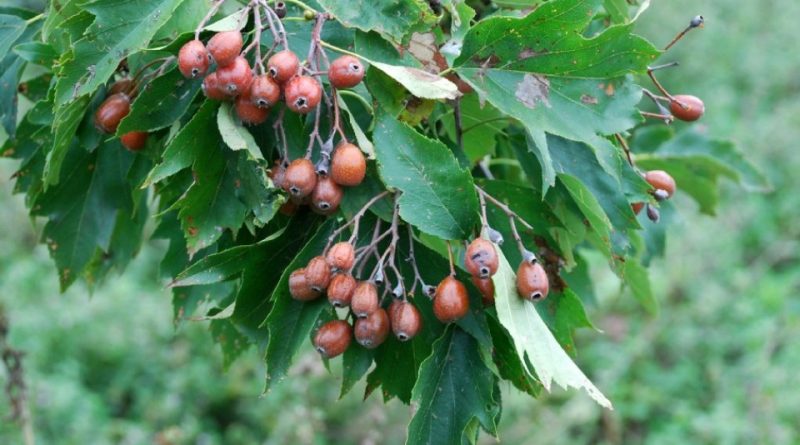Sorbus torminalis
Sorbus torminalis
The rowan ciavardello or simply rowan (Sorbus torminalis L.) is a tree of the Rosaceae family.
Systematics –
From the systematic point of view it belongs to the Eukaryota Domain, Kingdom Plantae, Magnoliophyta Division, Magnoliopsida Class, Rosales Order, Rosaceae Family and then to the Genus Sorbus and to the Specie S. torminalis.
Etymology –
The generic term Sorbus comes from the Latin sorbus, the name of the rowan in Pliny and Columella, derived from sórbeo sorbire, perhaps referring to the ripe and soft fruit from which to sip the fermented juice. The specific epithet torminalis derives from tormína, colic: able to soothe the colic; since in the past the fruits were used in the treatment of colitis.
Geographic Distribution and Habitat –
Sorbus torminalis is a species native to the temperate zones of Europe, western Asia and North Africa; it is found from the sea level up to 800 m. and forms mixed forests of broad-leaved heliophiles; we find it especially in deciduous woods of oak, white hornbeam, cerrete and transitional woods with the evergreen Mediterranean forest, shrubbery; it prefers sunny exposures and acid or sub-acid soils, clayey, deep, but it also adapts well to calcareous and stony substrates, it does not bear the shade; it is a pioneer species in the colonization of degraded areas. In Italy it is common throughout the Apennines and at the foot of the Alps.
Description –
The wild card is a tree that can reach 15 meters in height, with a dense, flattened and globose foliage. The trunk is straight, sometimes polyconic, with a grayish rind, first smooth with lenticels, then wrinkled and irregularly chapped. The leaves are deciduous, ovate, alternate, with narrow and regular lobes. It possesses hermaphrodite white flowers and reunited in broad and erect branchy corymbs, with hairy calyx with caducous triangular lacinities. The fruit is a small ovoid knob (1-1.5 cm), with a brownish rust color when ripe, with a very astringent taste.
Cultivation –
The wild card is a very beautiful, fast growing tree of great interest for the introduction into parks and gardens. It is a plant that is suitable for full sun but also for partial shade, but it does not cover the areas completely in the shade and is quite indifferent to the pH of the soil. The species is very rustic, although belonging to the Rosaceae does not fear scab or powder, is not the victim of aphids or other specific enemies. Like the other Rosaceae, however, it fears the attacks of rodent insects (Cossus cossus and Zeuzera pyrina) that greatly appreciate the soft woods like its own. Reproduction can take place either from seed or agamic way; obviously the agamic reproduction will guarantee us the preservation of the identical characters observed on the plant of origin, ie dimensions and colors of the leaves, size and taste of the fruits and carriage. In this case, then, we will have to resort to the grafting of selected mares for the characters that interest us on feet obtained from seed.
Uses and Traditions –
The Sorbus torminalis is distinguished by having a hard, fine-grained and compact, reddish-brown wood with lighter sapwood, much appreciated in cabinet making and luthiery for its acoustic properties. In fact, even if little considered is comparable to that of the Walnut. Once with the barks the skins were dyed red and brown.
Today it is probably not very commercialized because it is scarcely available.
It has a good content of vitamin C and in the past was used in the treatment of colitis.
For the beauty of spring bloom and for the color of the leaves that in autumn becomes bright red, it is currently used for ornamental purposes.
The small fruits remain on the plant until late winter and are particularly appetites for birds; for this reason S. torminalis as well as S. aucuparia is often planted at fixed hunting sites, and used to attract migratory birdlife.
The ancient Celts with fruits produced brandy and beer. It is a non-allergenic plant.
Preparation Mode –
With the ripe fruits of the wild card jams and syrups can be packaged, furthermore, after a scrupulous fermentation of the fruits, it is possible to obtain an excellent distillate, a product that is also marketed at an exorbitant price.
Guido Bissanti
Sources
– Acta Plantarum – Flora of the Italian Regions.
– Wikipedia, the free encyclopedia.
– Treben M., 2000. Health from the Pharmacy of the Lord, Advice and experience with medicinal herbs, Ennsthaler Publisher
– Pignatti S., 1982. Flora of Italy, Edagricole, Bologna.
– Conti F., Abbate G., Alessandrini A., Blasi C. (edited by), 2005. An annotated checklist of the Italian vascular flora, Palombi Editore.
Warning: Pharmaceutical applications and alimurgical uses are indicated for informational purposes only and do not in any way represent a medical prescription; there is therefore no liability for their use for curative, aesthetic or food purposes.


